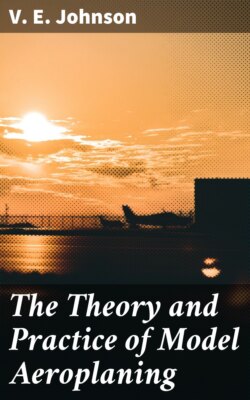Читать книгу The Theory and Practice of Model Aeroplaning - V. E. Johnson - Страница 7
На сайте Литреса книга снята с продажи.
CHAPTER I. THE QUESTION OF WEIGHT.
ОглавлениеTable of Contents
§ 1. The following is an extract from a letter that appeared in the correspondence columns of "The Aero."[2]
"To give you some idea how slight a thing will make a model behave badly, I fitted a skid to protect the propeller underneath the aeroplane, and the result in retarding flight could be seen very quickly, although the weight of the skid was almost nil.[3] To all model makers who wish to make a success I would say, strip all that useless and heavy chassis off, cut down the 'good, honest stick' that you have for a backbone to half its thickness, stay it with wire if it bends under the strain of the rubber, put light silk on the planes, and use an aluminium[4] propeller. The result will surpass all expectations."
§ 2. The above refers, of course, to a rubber-motor driven model. Let us turn to a steam-driven prototype. I take the best known example of all, Professor Langley's famous model. Here is what the professor has to say on the question[5]:—
"Every bit of the machinery had to be constructed with scientific accuracy. It had to be tested again and again. The difficulty of getting the machine light enough was such that every part of it had to be remade several times. It would be in full working order when something would give way, and this part would have to be strengthened. This caused additional weight, and necessitated cutting off so much weight from some other part of the machinery. At times the difficulty seemed almost heartbreaking; but I went on, piece by piece and atom by atom, until I at last succeeded in getting all the parts of the right strength and proportion."
How to obtain the maximum strength with the minimum of weight is one of the, if not the most, difficult problems which the student has to solve.
§ 3. The theoretical reason why weight is such an all-important item in model aeroplaning, much more so than in the case of full-size machines, is that, generally speaking, such models do not fly fast enough to possess a high weight carrying capacity. If you increase the area of the supporting surface you increase also the resistance, and thereby diminish the speed, and are no better off than before. The only way to increase the weight carrying capacity of a model is to increase its speed. This point will be recurred to later on. One of Mr. T.W.K. Clarke's well-known models, surface area 1¼ sq. ft., weight 1¼ lb., is stated to have made a flight of 300 yards carrying 6 oz. of lead. This works out approximately at 21 oz. per sq. ft.
The velocity (speed) is not stated, but some earlier models by the same designer, weight 1½ lb., supporting area 1½ sq. ft., i.e., at rate of 16 oz. per sq. ft., travelled at a rate of 37 ft. per second, or 25 miles an hour.
The velocity of the former, therefore, would certainly not be less than 30 miles an hour.
§ 4. Generally speaking, however, models do not travel at anything like this velocity, or carry anything like this weight per sq. ft.
An average assumption of 13 to 15 miles an hour does nor err on the minimum side. Some very light fabric covered models have a speed of less than even 10 miles an hour. Such, of course, cannot be termed efficient models, and carry only about 3 oz. per sq. ft. Between these two types—these two extremes—somewhere lies the "Ideal Model."
The maximum of strength with the minimum of weight can be obtained only:—
1. By a knowledge of materials.
2. Of how to combine those materials in a most efficient and skilful manner.
3. By a constant use of the balance or a pair of scales, and noting (in writing) the weight and result of every trial and every experiment in the alteration and change of material used. Weigh everything.
§ 5. The reader must not be misled by what has been said, and think that a model must not weigh anything if it is to fly well. A heavy model will fly much better against the wind than a light one, provided that the former will fly. To do this it must fly fast. To do this again it must be well powered, and offer the minimum of resistance to the medium through which it moves. This means its aerofoil (supporting) surfaces must be of polished wood or metal. This point brings us to the question of Resistance, which we will now consider.
